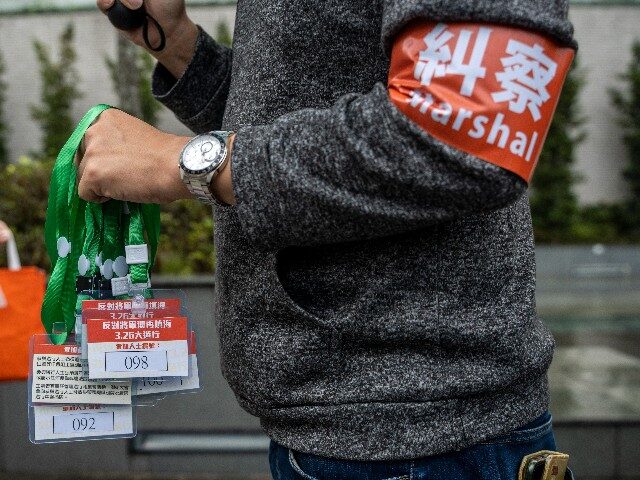A small group of about 80 people participated on Sunday in the first protest allowed in Hong Kong since the Wuhan coronavirus pandemic began — forced to wear humiliating number tags and flanked while marching by almost as many police officers as protesters.
The Hongkongers organized to object to the proposed construction of a garbage collection facility in their neighborhood, among other projects, that they claimed would damage the environment surrounding their homes. Reports following the protest indicated that, while objecting to a government plan, none of the participants expressed any general discontent with the political system or with the government of China, which in 2020, passed a “national security” law that effectively eliminated Hong Kong’s autonomy.
Under the “One Country, Two Systems” policy, which China agreed to when taking over the former British colony in 1997, China retained formal sovereignty over Hong Kong but could not impose communist laws over it, allowing Hong Kong to establish its own, separate legal system. The “national security” law ended “One Country, Two Systems” as it granted Hong Kong police the power to arrest and prosecute individuals for violating a law passed in Beijing. The law imposed a minimum ten-year prison sentence on individuals found guilty of “secession,” “terrorism,” or inviting “foreign interference” or “subversion of state power.”
Protest organizers told local media this weekend that the police granted its “letter of no objection,” the formal permit required for a protest to take place, with severe limitations on how the protesters could express their dissent. Among the requirements were that the protest could not attract more than 100 people, according to the Hong Kong-based South China Morning Post, and that no one unauthorized to march prior to the beginning of the protest could join in later. Police approved all individual people who chose to join the protest and assigned them numbers, which they had to hang prominently around their necks so police could identify them at all times:
Police also enforced a ban on wearing masks of any kind, including sanitary masks, at the protest on Sunday. Those who wished to wear a sanitary mask had to petition the police individually with a “reasonable” reason for wearing them, such as a health condition that made them particularly susceptible to severe coronavirus cases. Hong Kong passed a law banning the wearing of face coverings in public in October 2019 to crack down on anti-communist protests that swept the city that year, in response to a proposed Hong Kong law that would have allowed communist China to extradite individuals accused of violating Beijing’s laws within Hong Kong. The ban was part of a larger ban on costumes in anticipation of Halloween. Following the spread in the city of the novel coronavirus originating in Wuhan in early 2020, Hong Kong officials also passed a sanitary mask mandate, making it both obligatory and illegal to wear a mask simultaneously. Hong Kong dropped its mask mandate in February, shortly after the Communist Party rescinded its most extreme civil rights restrictions related to the pandemic within its legal territory.
“This means all our [coronavirus] measures have officially come to an end. Hong Kong has fully returned to normal,” Hong Kong’s chief health official, Lo Chung-mau, said in February.
While pandemic-related limitations ended, the repressive laws passed to end the pro-democracy protest movement remain intact. The South China Morning Post noted that protest organizers called the restrictions on their march against government land reclamation the “strictest” seen in the history of the local homeowner movement. The result was a slightly limited attendance — police allowed 100 protesters, but only about 80 showed up, even as 300 applied for one of the 100 allotted protest spots — surrounded by an estimated 50 police officers. Police cordoned off the route of the march to limit protesters’ mobility and keep them from reaching beyond a limited territory.
“Many were struggling with whether to come, after seeing the stringent conditions … But we had to accept it,” one protester told the Morning Post. “I hope those are just one-off conditions, we are definitely capable of holding peaceful assemblies.”
Some expressed hope that the protest occurring peacefully and without incident would result in less intense restrictions for the next event, though Hong Kong government officials did not indicate in any way that this would be the case. On the contrary, Hong Kong’s local government, closer to Beijing than ever, has kept the most prominent leaders of the 2019 pro-democracy protests whom it managed to arrest and keep behind bars for years, prosecuting them under the “national security” law.
Among the most prominent examples is Joshua Wong, a protest leader who joined movements against Chinese influence as a teen in 2014 and led the now-defunct pro-democracy group Demosisto. Wong is currently in prison serving multiple sentences for “crimes” such as wearing a mask in public, which he was convicted of doing in a court decision in 2021, long after the pandemic had begun.

COMMENTS
Please let us know if you're having issues with commenting.